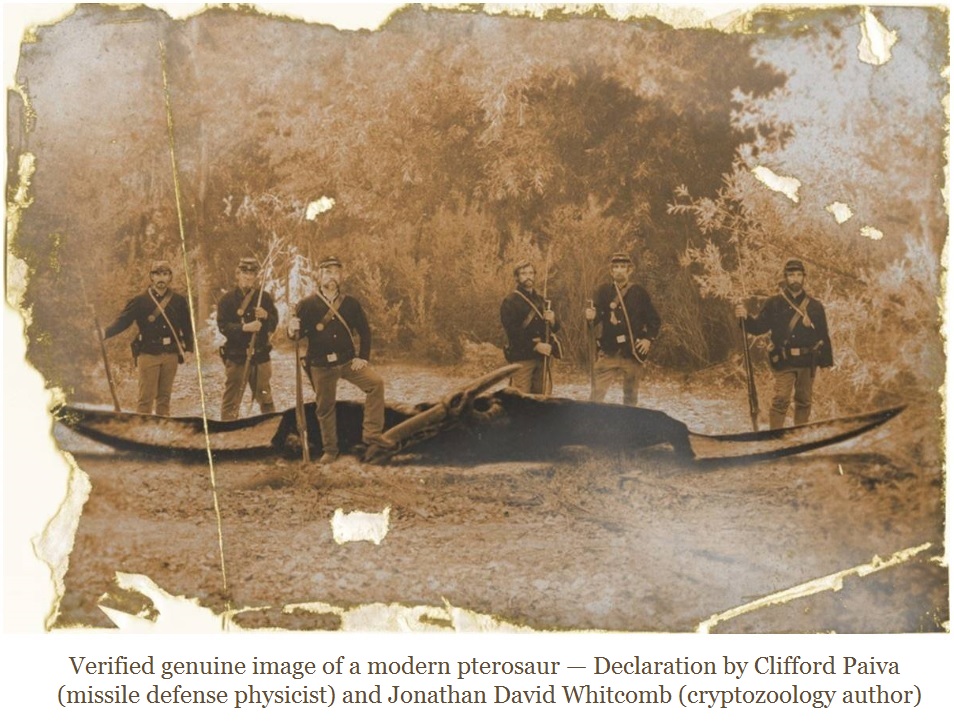Tag: cryptozoology
Genuine Photograph of an Extant Pterosaur
by admin on Mar.23, 2017, under Strange
On January 14, 2017, Clifford Paiva (a physicist in California) and Jonathan Whitcomb (a forensic videographer and cryptozoology author in Utah) jointly declared their belief in the authenticity of an old photograph that contains an image of an apparent recently-deceased Pteranodon.
Previous to that date, skeptics had dismissed the photo as being a hoax created by Photoshop. Paiva and Whitcomb, however, have declared that they have discovered numerous evidences that no digital image manipulation was involved and that the photo has distinctive evidence that it was recorded prior to 1870.
This is a study in cryptozoology, with an apparent “living fossil” that appears to have been a Pterodactyloid pterosaur. Paiva and Whitcomb stopped short of insisting that the animal was a species of Pteranodon, but they have pointed out the obvious similarities in appearance between this image and what is known from Pteranodon fossils.
.
“Ptp” photograph declared authentic by Paiva and Whitcomb, January 14, 2017
.
“Missing Fingers” and Photoshop
Prior to 2017, the most damaging apparent evidence against the photo were the missing fingers on the hand of the man on the far left. That lack of fingers was used by some skeptics to ridicule the image as a Photoshop hoax. But serious errors have been pointed out by Whitcomb, regarding the hand of that man.
According to Whitcomb, the way that those fingers would have gone missing from using Photoshop would have been in a digital cut-and-paste: A soldier-image would have had his arm out to his right (our left) as if holding a rifle but the rifle-image would be pasted over that part of his hand. In other words, a hoaxer would have had to find a photo of a soldier that had his arm out as if holding a rifle but without any rifle. That alone would shoot down the Photoshop conjecture, regarding those missing fingers. How many Civil War soldiers had their photographs taken while holding out their arms, as if holding their rifles, but without any rifle?
But Whitcomb found a reasonable explanation for the missing fingers. He noticed that another soldier was holding a rifle with the ram-rod showing. The soldier on the far left (with missing fingers), however, had a rifle in which the ram-rod was not visible. Apparently the rifle was turned in such a way the the ram-rod was behind the camera’s view. That soldier was holding his rifle by the ram-rod, making the ends of his fingers not visible to the camera.
Discovery by a Physicist
Paiva found a branch under the beak of the animal. It was, apparently, used as a prop to keep the man’s foot and the animal’s beak steady during the many seconds of exposure needed for the photograph. That length of time for the exposure of a photograph was necessary before about 1870, so props were often used to keep people perfectly still.
###
copyright 2017 Jonathan Whitcomb
.
The original Civil War pterosaur photo
The photograph now called “Ptp” has been around for a long time, possibly in one or more books in the mid-20th century, according to a number of persons who report remembering it.
A Pteranodon in a Civil War Photo
The American physicist Clifford Paiva found evidences of the photo’s authenticity, after examining the details. One of those was a shadow of the front soldier’s shoe on the beak of the animal. Paiva declared that this shadow is consistent with other nearby shadows.
Dinosaur or pterodactyl in a Civil War photograph
Years ago, a scientist in California began noticing details in a photograph, clues that the image of an apparent modern pterosaur was genuine. On January 14, 2017, I spoke with Clifford Paiva (a physicist) by phone. We agreed that the photo (now labeled “Ptp”) has a genuine photographic image of a modern pterosaur. Some people call this kind of animal a “flying dinosaur” or a “pterodactyl.”
Skeptical Responses to Civil War Pteranodon Photo
The dead flying creature seen in the “Pteranodon photograph,” (Ptp) although it may be called a “pterodactyl” by some Americans and a “ropen” by others, could be a pterodactyloid pterosaur, possibly without the long tail that ropens are seen to have.
.
Cryptozoology and Hoaxes (or not)
by admin on Feb.12, 2010, under Strange
One of the challenges for those pursuing cryptozoology (or those pursuing the cryptids themselves) is the possibility of a hoax. How do we know that a proclaimed eyewitness is not pulling a prank? Did a middle-aged couple in Scotland really see something slithering across the road one night, slipping back into Loch Ness? Did an American hunter really see something like a Big Foot in Oregon?
Frozen “Big Foot” in Georgia
It turned out to be just a Halloween costume. But the news media jumped on the report, for a deputy sheriff seemed to be putting his career on the line (why would he risk his career for a hoax?). Well, that deputy sheriff did have his career shot down, for the frozen “Big Foot” was a hoax.
Eyewitnesses of Living Pterosaurs
A press release seems to show an objective look at hoax possibilities with alleged pterosaur sightings in the United States. (See Reports of Live Pterosaurs) Three seperate factors were analyzed, with the conclusion that hoaxes could not have caused the majority of the sighting reports. To some skeptics, it seems to be too good to be true: living pterosaurs in the United States. But nobody seems to have come up with a reasonable response to the analysis of the statistics about wingspan, featherlessness details, and long-tail dominance.


